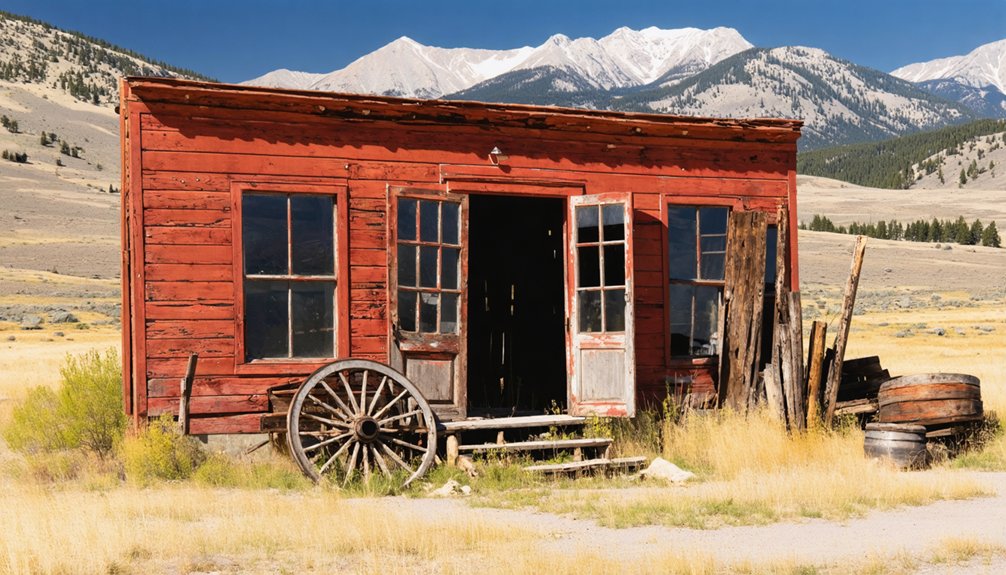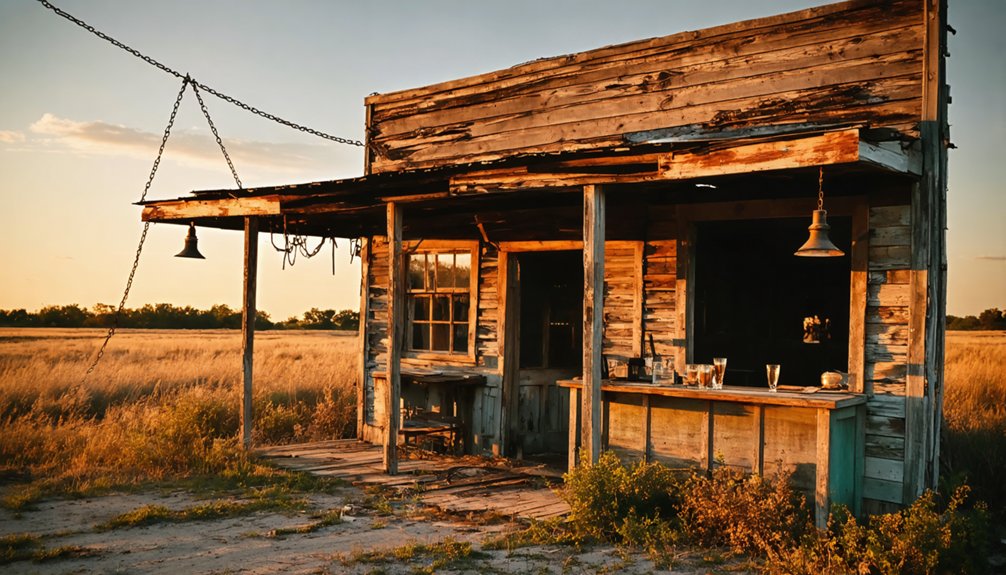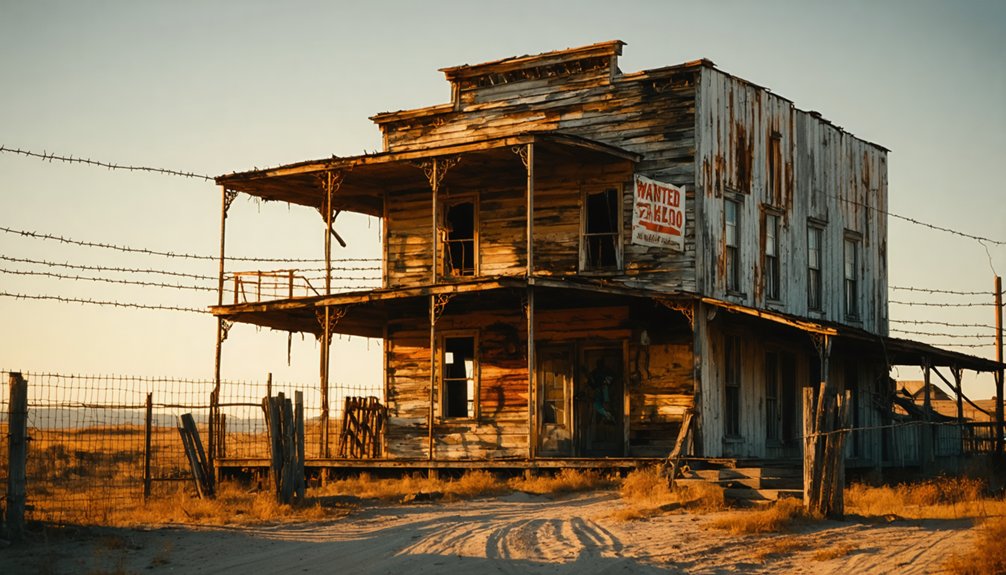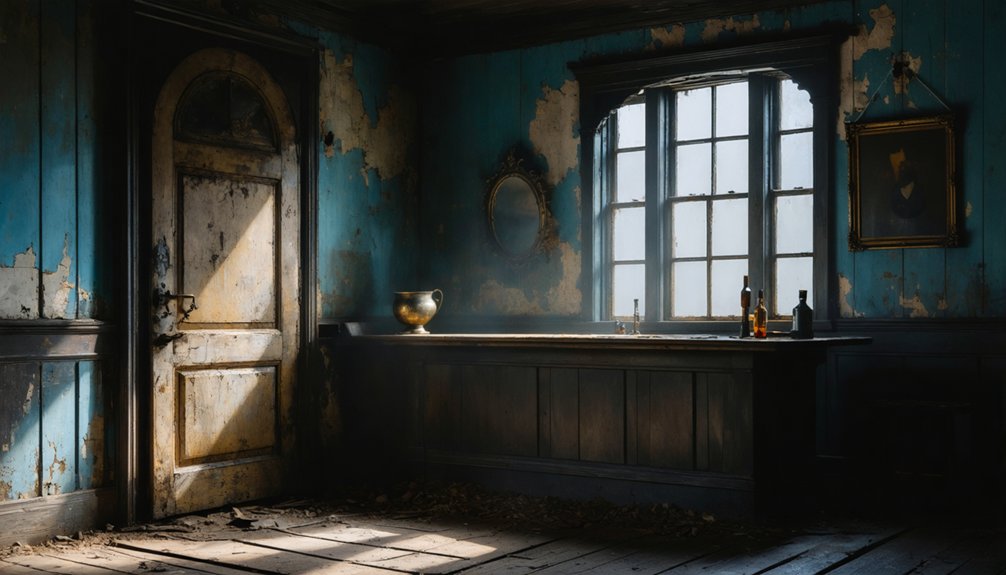You’ll find seven enchanting ghost towns near Yellowstone that transport you to the Gold Rush era. Virginia City and Nevada City showcase authentic 1860s buildings with original furnishings, while Bannack State Park preserves 60 structures including the infamous vigilante gallows. Don’t miss Garnet’s restored J.R. Wells Hotel, Kirwin’s high-altitude mining relics, and South Pass City’s operational Gold Mining Center. These weathered wooden boardwalks and abandoned saloons hold stories of fortune-seekers you’ll want to uncover.
Key Takeaways
- Virginia City and Nevada City preserve authentic Gold Rush history with over 100 original buildings just an hour from Yellowstone.
- Bannack State Park features 60 original structures including the governor’s mansion from Montana’s first territorial capital.
- Garnet Ghost Town sits at 6,000 feet elevation in Montana’s mountains with well-preserved structures like the J.R. Wells Hotel.
- Kirwin in Wyoming’s Absaroka Mountains contains mining equipment and Amelia Earhart’s unfinished cabin ruins at 9,000 feet.
- South Pass City preserves 20 original structures from Wyoming’s gold boom and operates an interpretive center for visitors.
Virginia City: The Best-Preserved Gold Rush Boomtown
Just an hour’s drive from Yellowstone’s western boundary, Virginia City stands frozen in time as Montana’s most remarkably preserved gold rush boomtown. When gold was discovered in Alder Gulch in 1863, it triggered an explosion of fortune-seekers that transformed this spot into a thriving metropolis of 10,000 souls within months.
The Historical Significance of this former territorial capital can’t be overstated—over $150 million in gold flowed from these hills, shaping Montana’s destiny. The area became known as Fourteen-mile City due to continuous settlements stretching along the entire gulch. What began as a chaotic collection of mud huts and tents eventually evolved into an organized town with Victorian-style homes that reflected its growing prosperity.
You’ll walk the same boardwalks as ambitious miners and cunning entrepreneurs who created an Economic Impact that echoed across the West.
Today, you can explore over 100 authentic buildings with original furnishings, ride a vintage steam locomotive, or join gold rush-themed tours that bring the wild days of yesterday roaring back to life.
Nevada City: A Living Museum of Montana’s Mining Heritage
While Virginia City often steals the spotlight, a mere 1.5 miles down the dusty road lies Nevada City—its equally fascinating sister settlement born from the same legendary gold discovery.
In the shadow of its famous sibling, Nevada City awaits—a hidden treasure sharing the same golden origins.
This meticulously reconstructed mining town transports you to the 1860s when prospectors struck it rich in Alder Gulch. You’ll walk among more than 100 historic buildings, 14 original to the camp, witnessing the evolution of mining techniques from simple sluice boxes to hydraulic operations.
What makes Nevada City remarkable is its phoenix-like story—the original settlement was completely destroyed by dredging, then lovingly rebuilt through the Boveys’ preservation efforts. The preservation work has maintained original architectural features that give visitors an authentic glimpse into 19th-century mining life.
Charles and Sue Bovey rescued and relocated many historic buildings in the 1940s to save these architectural treasures from demolition.
Don’t miss the Music Hall’s unparalleled collection of historic player pianos or the chance to try gold panning yourself. At just 88 miles from Yellowstone, this living museum offers an authentic glimpse into Montana’s golden past.
Bannack State Park: Montana’s First Territorial Capital
You’ll step onto wooden boardwalks where Montana’s first territorial government took shape, witnessing the preserved buildings of a town that transformed from gold-mining boomtown to historic ghost town.
As you explore the main street, you’ll encounter the legacy of notorious Sheriff Henry Plummer, who secretly led a murderous gang of road agents before vigilantes hanged him in 1864. The Vigilance Committee took justice into their own hands, executing twenty-two individuals in their campaign to restore order to the lawless frontier.
Your footsteps will echo through the weathered structures where thousands once sought fortune during the 1862 gold rush that put Bannack on the map. The exceptionally high-quality gold deposits found here were 99.5% pure, drawing prospectors from across the country.
Walking Through History
Stepping onto the weathered wooden boardwalks of Bannack State Park transports you directly into Montana’s territorial beginnings, where history isn’t just preserved—it’s palpably alive.
You’ll wander through over 60 authentic structures where Montana’s first territorial government took shape in 1864, including the governor’s mansion where vigilante leader Sidney Edgerton once resided.
Unlike many historical sites focused on restoration, Bannack embraces historical preservation in its purest form.
During your ghost town exploration, you’re free to enter most buildings—from the old jail to saloons and mining cabins—all maintained in their authentic state.
The railroad’s decision to bypass this once-bustling hub sealed its fate, transforming it into the abandoned treasure you’re exploring today.
It’s like walking through an untouched page of Western history.
Bannack was founded in 1862 after prospectors discovered gold at Grasshopper Creek, triggering a rush of miners and entrepreneurs to this remote Montana location.
The town’s population exploded from just 400 people in 1862 to over 3,000 by spring of the following year as news of the gold discovery spread.
Gold Rush Beginnings
When gold flecks gleamed in the waters of Grasshopper Creek on July 28, 1862, they sparked Montana’s first major gold rush and birthed the legendary settlement of Bannack.
You’re standing where over 3,000 prospectors once flocked, extracting more than $500,000 in precious metal during the first year alone.
This bustling gold discovery transformed what was then Idaho Territory, propelling Sidney Edgerton to petition Congress for Montana’s territorial status.
By 1864, Bannack—named for the Bannock tribe but misspelled due to a clerical error—became Montana’s first territorial capital.
Walk the same streets where the first territorial legislature convened, surrounded by remnants of a once-thriving mining legacy: assay offices, saloons, and the imposing Hotel Meade that later served as the courthouse.
Today, visitors can explore about 60 historic buildings still standing in the preserved ghost town.
Visitors can experience the rich history through guided town tours and gold panning activities available from Memorial Day through Labor Day.
Sheriff Henry Plummer’s Legacy
While gold fever gripped Montana’s new territory, a darker story unfolded through the controversial figure of Henry Plummer, whose dual life as both lawman and outlaw epitomizes the chaos of frontier justice.
When you visit Bannack today, you’ll walk the same streets where Plummer’s infamy grew after his 1863 election as sheriff. Rather than bringing order, he secretly led the “Innocents” gang, orchestrating over 100 murders and countless gold robberies.
The citizens’ response was swift and merciless—vigilante justice delivered through midnight raids and summary hangings.
Stand beneath the preserved gallows where Plummer met his fate on January 10, 1864, and you’ll feel the weight of this lawless era.
The mysterious “3-7-77” vigilante code still adorns Montana Highway Patrol badges, a lasting reminder of frontier-style accountability.
Garnet Ghost Town: Montana’s Best-Kept Secret

Nestled at the head of First Chance Creek in Montana’s rugged Garnet Mountains, Garnet Ghost Town stands as a time capsule of the American West’s golden era.
Just 35 miles northeast of Missoula at 6,000 feet elevation, this remarkably preserved mining town offers scenic views that’ll transport you back to 1898 when its population peaked at 1,000 fortune-seekers.
Garnet history began in 1895, originally named Mitchell before adopting its gemstone moniker.
You’ll discover Montana’s most intact ghost town while exploring the meticulously restored J.R. Wells Hotel and Kelly’s Bar.
When gold prices plummeted and a devastating 1912 fire struck, Garnet slowly emptied.
Now managed by the Bureau of Land Management, this atmospheric mountain retreat welcomes 24,000 annual visitors seeking freedom and connection to America’s frontier past.
Kirwin: A Remote Wyoming Mining Camp Frozen in Time
You’ll find Kirwin nestled deep in Wyoming’s Absaroka Mountains at over 9,000 feet elevation, accessible only by four-wheel drive through rugged Shoshone National Forest terrain.
Steam-powered hoists, three-story headframes, and ore-processing equipment still litter this remarkably preserved ghost town, standing as silent witnesses to its abrupt 1907 abandonment.
As you explore the abandoned mine shafts and weathered wooden structures, you’re literally walking through a mining camp frozen in the moment its residents fled following a devastating avalanche that killed three people and fueled superstitions of a curse.
Remote Wilderness Location
Deep in Wyoming’s rugged Absaroka Mountains, Kirwin stands as a monument to frontier ambition, frozen in time since its abrupt abandonment over a century ago.
Reaching this remote exploration gem requires determination—you’ll need a high-clearance four-wheel-drive vehicle to navigate Forest Service Road 200, ending 38 miles southwest of Meeteetse.
The journey rewards you with breathtaking 12,000-foot peaks surrounding this wilderness preservation site. Most visitors must park seven miles downstream at lower elevation camping areas accessible by standard vehicles.
From there, the adventure truly begins. The site’s extreme isolation has preserved mining equipment exactly where workers left it in 1907, now rusted and embraced by mountain vegetation.
For the truly adventurous, a short hike from Kirwin leads to Amelia Earhart’s cabin ruins.
Abandoned Mining Equipment
The rusted giants of Kirwin’s mining heyday still stand sentinel throughout this mountain ghost town, telling stories of frontier industriousness through their silent presence.
You’ll discover braided steel cables with frayed ends that once hoisted ore from 600-foot depths, alongside conveyor belts that transported precious minerals throughout the operation.
The abandoned machinery includes ore crushers and smelting furnaces from the assay office where gold and silver were extracted from pulverized rock.
Drilling steels and evidence of dynamite operations hint at the dangerous conditions miners endured.
Thanks to Kirwin’s remote location at 9,000 feet elevation, these mining relics remain remarkably intact—frozen in time by harsh mountain weather yet protected from looting by difficult access that requires your four-wheel drive vehicle.
South Pass City: Gateway to Western Gold Fields

Golden dreams and frontier fortunes sprang to life at South Pass City following a momentous 1867 gold discovery that transformed this Oregon Trail junction into Wyoming’s most promising boomtown.
You’ll walk among 20 original structures where miners once extracted an estimated $7 million in precious metals from claims like the Bullion Mine, which alone produced 21,000 ounces of gold.
As you explore this State Historic Park, you’ll witness the dramatic rise and fall of gold mining operations that peaked in 1870 before quickly declining.
Don’t miss the operational Gold Mining Interpretive Center with its working stamp mill. The historical significance extends beyond mining—this area served as a Pony Express station and crucial migration route.
For a complete frontier experience, visit nearby ghost towns Miner’s Delight and Atlantic City.
Planning Your Yellowstone Ghost Town Adventure
Planning a ghost town adventure near Yellowstone reveals a forgotten world where America’s frontier dreams once flourished and faded.
You’ll discover multiple routes connecting these preserved relics, from the five-day journey between Glacier and Yellowstone to the organized ghost town trail across Southwest Montana.
For authentic immersion, camp under star-filled skies at Bannack State Park’s 28-site campground or boondock on BLM land near Garnet (staying 0.5 miles from the ghost town).
Both options provide perfect dawn lighting for ghost town photography.
Time your visit between May and September when sites like Old Trail Town in Cody are fully accessible.
Grab free brochures at visitor centers to understand the historical preservation efforts that maintain these weathered structures.
Montana’s 60 original buildings at Bannack represent frontier architecture at its most haunting and genuine.
Frequently Asked Questions
Are Any of These Ghost Towns Reportedly Haunted?
You’ll encounter haunted legends throughout these towns. Bannack and Virginia City in Montana and Wyoming’s Kirwin are hotspots for ghostly sightings, with apparitions in period clothing wandering their abandoned streets.
Can I Pan for Gold in These Historic Mining Towns?
Strike gold in your adventures! You can pan at Virginia City, Nevada City, and Bannack State Park where gold panning techniques are demonstrated alongside mining history tours. Just check local regulations first.
What Wildlife Encounters Are Common Near These Ghost Towns?
You’ll encounter bears, wolves, elk, and bison as they reclaim these forgotten spaces. Wildlife photography opportunities abound, especially during migration seasons when animal behavior reveals nature’s raw, untamed freedom.
Are There Guided Night Tours of These Abandoned Towns?
Picture yourself clutching a lantern at dusk in Virginia City. You’ll find limited night tour options near Yellowstone, with some seasonal lantern-lit events rather than regular guided experiences at these historic sites.
Can I Metal Detect or Collect Artifacts at These Sites?
You’ll face strict metal detecting regulations at these historic sites. Most ban artifact collection entirely to protect preservation concerns. Try joining historical societies instead—they offer legal ways to engage with these abandoned treasures.
References
- https://www.yellowstonepark.com/things-to-do/attractions/ghost-town/
- https://en.wikipedia.org/wiki/Wikipedia:WikiProject_Ghost_towns
- https://glaciermt.com/ghost-towns
- https://www.youtube.com/watch?v=tYxwkDCs3o4
- https://en.wikipedia.org/wiki/List_of_ghost_towns_in_Montana
- https://www.geotab.com/ghost-towns/
- https://destinationyellowstone.com/ghost-towns-and-hidden-history-near-yellowstone/
- https://www.youtube.com/watch?v=LJ6lJysct2c
- https://visitmt.com/trip-ideas/ghost-town-route
- https://noospheregeologic.com/blog/tag/ghost-towns/



